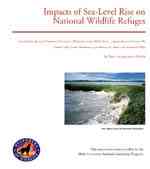There are more than 150 national wildlife refuges located in coastal areas. For these refuges, sea-level rise has the potential to reshape wetlands, shift habitats inland and upland, and even put large parts of some refuges entirely underwater. Yet when planning to acquire new land, the Refuge System does not take projections of sea level rise or other climate impacts into account. If it is making fee-title acquisitions or purchasing long-term easements on lands that are going to be underwater within a few decades, the U.S. Fish and Wildlife Service may not be making the most effective conservation investments.
Defenders’ climate team used the Sea Level Affecting Marshes Model (SLAMM) to assess the threat to the lands within both the acquired and approved boundaries of eight coastal refuges that have been assigned a high funding priority for land acquisitions in the coming year. We found that sea-level rise impact will not be felt equally among coastal refuges. Two of the refuges we assessed could lose over 40% of their land by 2075 if sea level rises by one meter over the course of the century. On the other hand, four of the refuges have less than 5% of their land area vulnerable. Some refuges will face flooding but have newly-created wetlands nearby, where the refuge could potentially expand to. Others will face wetland loss that will not be readily replaced with new areas of marsh. And refuges whose land area consists mainly of low-lying islands may run out of land entirely.
The Fish and Wildlife Service urgently needs to better understand and incorporate climate change and sea level rise implications into its land acquisition planning to avoid investments that will ultimately be literally underwater.
Our summary report with policy recommendations is available here.
The complete report is available here.

